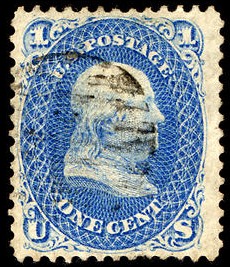De Meest Waardevolle Postzegels ter Wereld
De Meest Waardevolle Postzegels ter Wereld
Waardevolle postzegels kunnen in veel verschillende vormen, kleuren en grootten voorkomen en elk van deze heeft zeer interessante verhalen te vertellen. Sinds de eerste uitgifte van de Penny Black in de jaren 1900, hebben postzegels hun permanente stempel in de geschiedenis gedrukt en zijn ze uitgegroeid tot een van de meest gewenste items van een verzamelaar. Zegels zijn minuscule stukjes vervaagd papier ter nagedachtenis aan historische gebeurtenissen en opvallende gezichten die werden gebruikt om brieven op enveloppen vooraf te betalen en die werden ontvangen door onze voorouders - wie had gedacht dat dergelijke postzegels nu een fortuin waard zijn? In het geval dat je toevallig een zeldzame postzegel hebt gevonden, is het misschien een van de meest waardevolle postzegels die er zijn, als je geluk hebt.
The zeldzaamste en duurste postzegels in de wereld
Voor serieuze postzegelverzamelaars zijn zeldzame postzegels en zegels met fouten het belangrijkste doelwit om te vinden. Naarmate de tijd verstrijkt, kunnen de waarden van postzegels ongelooflijk stijgen, sommige zelfs meer dan een miljoen Amerikaanse dollars. Heb je je ooit afgevraagd wat de meest waardevolle postzegels ter wereld zijn? Nog steeds bekend als de "King of Hobbies" of de "Hobby of Kings", zal het verzamelen van postzegels altijd rond zijn zolang er postzegelverzamelaars zijn die bereid zijn veel geld uit te geven om zeldzame en waardevolle postzegels te verwerven. Degenen die daartoe in staat waren, zagen hun investeringen in een redelijk korte tijd verdubbelen (of zelfs verdrievoudigen) in waarde. Hieronder staan enkele van de zeldzaamste en meest waardevolle zegels ter wereld. Houd er rekening mee dat dankzij de altijd beschikbare vraag de prijzen zijn gestegen. Houd er ook rekening mee dat er nieuwe filatelistische zeldzaamheden kunnen worden ontdekt, dus het loont de moeite om uw zegelalbums dubbel te controleren.
-
Mauritius ‘Postkantoor’
Land: Mauritius
Geschatte waarde: ongeveer US $ 1,67 miljoen
Reden waarom het een van 's werelds waardevolle zegels is: printfout (de afgedrukte woorden Post Office moeten Post Paid zijn)

In September 1847 werden de postzegels van Mauritius 'Post Office' uitgegeven in Mauritius, een Britse kolonie. De postzegels zijn er in 2 coupures: een penny oranjerood; en een twee pence diep blauw. Deze postzegels zijn gegraveerd door Joseph Barnard, die de postzegels heeft ontworpen op basis van de postzegels van Groot-Brittannië die voor het eerst werden uitgebracht in 1841 (hoofd van koningin Victoria en uitgebracht in twee denominaties van dezelfde kleuren: een één cent roodbruin en een twee cent blauw) . Zelfs als deze stempels lokaal werden gemaakt en een nogal primitief / inheems kenmerk hadden, maakten zij de naam van Barnard legendarisch in de postale geschiedenis van Mauritius.
Er werden 500 van elke waarde afgedrukt en uitgegeven op 21 september 1847, en veel van deze zegels werden gebruikt op uitnodigingen verstuurd naar vrienden en beroemdheden van Lady Gomm, de vrouw van de gouverneur van Mauritius, voor een bal die zij georganiseerd had voor dat weekend.
De woorden "Postkantoor" zijn te zien aan de linkerkant van de postzegel, maar bij de volgende aflevering in 1848 werden deze vervangen door "Post Betaald". Veel postzegelverzamelaars geloven dat de woorden "Postkantoor" een fout waren.
Wat de postzegels van het postkantoor van Mauritius tot enkele van de meest waardevolle postzegels ter wereld maakten, is omdat het deel uitmaakt van de gewaardeerde collecties van beroemde of prominente postzegelverzamelaars zoals: Alfred F. Lichtenstein (Amerikaans filatelist), Arthur Hind ( Amerikaans industrieel en filatelist), Alfred Caspary (filatelist), Henry J. Duveen (kunsthandelaar en filatelist), Sir Ernest de Silva (zakenmagnaat en filatelist uit Ceylon) en Sir William Beilby Avery (baronet en Britse filatelist).
Wat de postzegels van het postkantoor van Mauritius tot enkele van de meest waardevolle postzegels ter wereld maakten, is omdat het deel uitmaakt van de gewaardeerde collecties van beroemde of prominente postzegelverzamelaars zoals: Alfred F. Lichtenstein (Amerikaans filatelist), Arthur Hind ( Amerikaans industrieel en filatelist), Alfred Caspary (filatelist), Henry J. Duveen (kunsthandelaar en filatelist), Sir Ernest de Silva (zakenmagnaat en filatelist uit Ceylon) en Sir William Beilby Avery (baronet en Britse filatelist).
De beste van alle Mauritius Postkantoor collecties is in handen van Hiroyuki Kanai, die ongebruikte exemplaren van de one-penny en two-pence zegels heeft, genaamd "Bordeaux Cover". Deze Bordeaux-cover werd "La piece de resistance de toute la philatelie" ("Het grootste item in alle filatelie") genoemd. Deze verzameling Kanai werd in 1993 verkocht via David Feldman (veilingmeester), met een prijs van ongeveer US $ 4 miljoen.

Er zijn slechts 26 bekende stukken van de postzegels van het Mauritius Postkantoor die vandaag bestaan: veertien stuivertjes van één stuiver en twaalf stuivertjes van twaalf. In 2011 werd een tweeledig blauwe poststempel van Mauritius op een veiling verkocht voor £ 1,05 miljoen (US $ 1,67 miljoen) in het Verenigd Koninkrijk.
-
US Benjamin Franklin Z-Grill
Land: Verenigde Staten
Geschatte waarde: ongeveer 8,8 miljoen US $
Reden waarom het een van 's werelds waardevolle zegels is: Z-patroon dat uniek is bij grill-sjablonen die worden gebruikt door de USPS

In February 1868, the United States Postal Service issued a 1-cent postage stamp featuring Benjamin Franklin. These stamps were common at the time, but what separates some of them from the others is the Z-Grill. The "Z" variant of a grill is pressed into the stamp, thereby creating tiny indents embossed into the paper. Grilling allows the cancellation ink to be readily absorbed into the paper, thus preventing people from reusing the stamps via washing out the cancellation marks. The grills were deemed to be impractical to use and so they were discontinued after 1870.
Only two Z-Grill stamps remain up to this day, and both have cancellation marks. The first Z-Grill is part of the Benjamin Miller Collection owned by the New York Public Library.

The second Z-Grill's story started in 1998. It was sold for $935,000 to the stamp dealer Mystic Stamp Company. Siegel Auctions hosted the auction and placed the stamp as part of the Robert Zoellner collection.
In October 2005, Mystic Stamp Company President Donald Sundman traded the Z-Grill to Bill Gross, a financier, for a block of 4 Inverted Jenny stamps which were worth almost US$3 million. Bill Gross then became the owner of the only complete US 19th Century Stamp collection.
From May 27, 2006 up until October 1, 2007, these two Z-Grills were put on display at the National Postal Museum, along with the first portion of the Benjamin Miller Collection.
The Z-Grill is considered to be one of the rarest and most valuable stamps in the US (and also the world), and the present estimated valuation of the stamp is at US$8.8 million.
-
Inverted Jenny/ Omgedraaide Jenny
Land: Verenigde Staten
Estimated Value: About US$2.7 million
Reason Why It's One of the World's Valuable Stamps: Print error (image is upside down)

In May 10, 1918, the United States first issued the postage stamps of the Inverted Jenny, Jenny Invert or Upside Down Jenny. It was the first stamp ever in the US that was issued for air delivery. The image shows the Curtiss JN-4 airplane in the middle part of the design, which is distinctively upside down.
These stamps were printed on sheets of 100; however, each sheet had to be run twice through the printing machine. Thus, one pane was accidentally flipped on the second pass, which caused the error. They were already sold to the public before the error was eventually noticed. Since there was only one pane of 100 of these inverted stamps that were found, this print error stamp is probably the most famous error and one of the most valuable stamps in the history of philately.
In October 2005, a unique plate number block of 4 Inverted Jenny stamps worth US$2.7 million was bought by US financier Bill Gross. After purchasing the Inverted Jennys, he then traded them shortly with Donald Sundman, president of the Mystic Stamp Company (a stamp dealer), for one of the two only known surviving specimens of the Us Benjamin Franklin Z-Grill. Because of the trade, Bill Gross became the title-holder of the only complete collection of 19th Century US stamps.
-
Drie Skilling geel
Land: Zweden
Geschatte waarde: Meer dan $3.14 Miljoen US Dollar
Reason Why It's One of the World's Valuable Stamps: Printing Error (Color should be blue-green, not yellow)

The Treskilling Yellow, or three schilling banco error of color, is a postage stamp from Sweden in which there is only one example of it that exists today.
In 1855, Sweden had issued its very first postage stamps that featured the Swedish coat of arms. The stamps issued were in 5 different denominations and colors: 3 (color Blue-green), 4 (Blue), 6 (Gray), 8 (Yellow), and 24 (Red) Skilling Banco. It is not really known what went wrong, but because of a printing error, instead of the usual blue-green color, one of the 3 skilling stamps came out on the yellow-orange paper which was actually used for the 8 skilling stamp.

A screenshot image taken from the StampWorld online catalogue, you will see the 5 series of the first postage stamps issued in Sweden. Klik hier om naar de catalogus van Zweden te gaan.
The error went unnoticed until 1886 when a young stamp collector named Georg Wilhelm Backman discovered the stamp while going through covers in his grandmother's attic.
The exact quantity of these stamps mistakenly printed is not really known. Therefore, the Treskilling Yellow is deemed to be a one-of-a-kind rare stamp, because no other copies have been found yet.
In 1996, it was auctioned in Geneva, Switzerland and sold for at least US$2.3 million. In May 2013, it was acquired through a private sale by a Swedish politician and nobleman named Count Gustaf Douglas.
-
Brits-Guiana één cent zwart op magenta
Land: Brits-Guiana (nu Guyana)
Geschatte waarde: Rond $9.5 miljoen US Dollar
Reason Why It's One of the World's Valuable Stamps: Produced due to stamp shortage

In 1856, there was a stamp shortage in British Guiana because a ship from London, England that was supposed to be carrying stamps to British Guiana was delayed. To solve the shortage problem, the local postmaster requested that the local newspaper printers print some temporary stamps. The printers created 3 types: a 4-cent stamp in blue; and a 1-cent stamp and a 4-cent stamp in magenta.
Because they were only mere temporary stamps and nothing special, the postmaster decided that the stamps had to be simply initialed by an employee of the post office as a way to make sure of their authenticity, and to prevent forgery. The stamp was cut on its corners in a way that it looks like an octagon.
It was first owned by a Scottish boy aged 12 years old who lived in South America during 1873. Surprisingly, the 1-cent magenta stamp has become one of the most valuable stamps as the time passed by. For the past 141 years, this stamp has been bouncing to and fro one collector to another, being sold privately or at public auctions for ever-increasing sale values. One of the main reasons it was deemed as one of the world's valuable stamps is because it was purchased by Count Philipp la Renotiere von Ferrary, a man known to be one of the world's greatest stamp collectors.
In the 21st century, the British Guiana one-cent Black on Magenta postage stamp is known by many stamp collectors and philatelists as the world's rarest, most famous and most valuable stamp. It is considered a rare stamp that was issued in British Guiana (known today as Guyana) during 1856 in very limited numbers. It is the only one stamp known to exist today. This stamp was sold in June 17, 2014 for a whopping $9,500,000 (9.5 million)!
